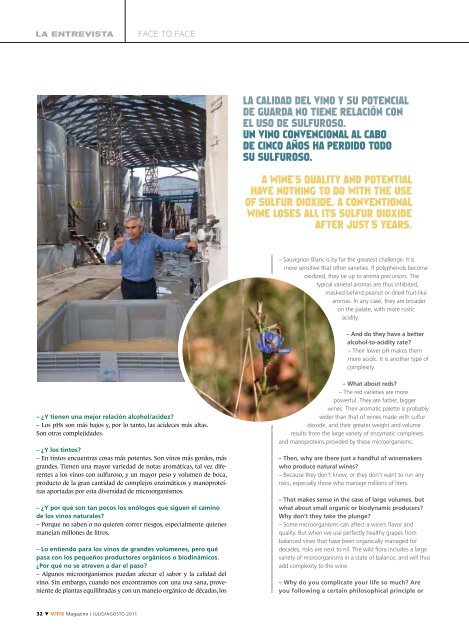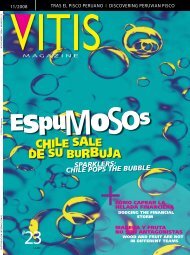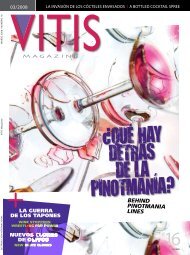VINOS DE PARRAS ANTIGUAS - Vitis Magazine
VINOS DE PARRAS ANTIGUAS - Vitis Magazine
VINOS DE PARRAS ANTIGUAS - Vitis Magazine
You also want an ePaper? Increase the reach of your titles
YUMPU automatically turns print PDFs into web optimized ePapers that Google loves.
la entrevista face to face<br />
– ¿Y tienen una mejor relación alcohol/acidez?<br />
– Los pHs son más bajos y, por lo tanto, las acideces más altas.<br />
Son otras complejidades.<br />
– ¿Y los tintos?<br />
– En tintos encuentras cosas más potentes. Son vinos más gordos, más<br />
grandes. Tienen una mayor variedad de notas aromáticas, tal vez diferentes<br />
a los vinos con sulfuroso, y un mayor peso y volumen de boca,<br />
producto de la gran cantidad de complejos enzimáticos y manoproteínas<br />
aportadas por esta diversidad de microorganismos.<br />
– ¿Y por qué son tan pocos los enólogos que siguen el camino<br />
de los vinos naturales?<br />
– Porque no saben o no quieren correr riesgos, especialmente quienes<br />
manejan millones de litros.<br />
– Lo entiendo para los vinos de grandes volúmenes, pero qué<br />
pasa con los pequeños productores orgánicos o biodinámicos.<br />
¿Por qué no se atreven a dar el paso?<br />
– Algunos microorganismos puedan afectar el sabor y la calidad del<br />
vino. Sin embargo, cuando nos encontramos con una uva sana, proveniente<br />
de plantas equilibradas y con un manejo orgánico de décadas, los<br />
32 ▼ <strong>Vitis</strong> <strong>Magazine</strong> l julio/agosto 2011<br />
LA CALIDAD DeL vINO y SU pOteNCIAL<br />
De gUARDA NO tIeNe ReLACIóN CON<br />
eL USO De SULfUROSO.<br />
UN vINO CONveNCIONAL AL CABO<br />
De CINCO AñOS hA peRDIDO tODO<br />
SU SULfUROSO.<br />
A wINe’S qUALIty AND pOteNtIAL<br />
hAve NOthINg tO DO wIth the USe<br />
Of SULfUR DIOxIDe. A CONveNtIONAL<br />
wINe LOSeS ALL ItS SULfUR DIOxIDe<br />
AfteR jUSt 5 yeARS.<br />
– sauvignon Blanc is by far the greatest challenge. it is<br />
more sensitive that other varieties. if polyphenols become<br />
oxidized, they tie up to aroma precursors. the<br />
typical varietal aromas are thus inhibited,<br />
masked behind peanut or dried fruit-like<br />
aromas. in any case, they are broader<br />
on the palate, with more rustic<br />
acidity.<br />
– And do they have a better<br />
alcohol-to-acidity rate?<br />
– their lower ph makes them<br />
more acidic. it is another type of<br />
complexity.<br />
– What about reds?<br />
– the red varieties are more<br />
powerful. they are fattier, bigger<br />
wines. their aromatic palette is probably<br />
wider than that of wines made with sulfur<br />
dioxide, and their greater weight and volume<br />
results from the large variety of enzymatic complexes<br />
and manoproteins provided by these microorganisms.<br />
– Then, why are there just a handful of winemakers<br />
who produce natural wines?<br />
– Because they don’t know, or they don’t want to run any<br />
risks, especially those who manage millions of liters.<br />
– That makes sense in the case of large volumes, but<br />
what about small organic or biodynamic producers?<br />
Why don’t they take the plunge?<br />
– some microorganisms can affect a wine’s flavor and<br />
quality. But when we use perfectly healthy grapes from<br />
balanced vines that have been organically managed for<br />
decades, risks are next to nil. the wild flora includes a large<br />
variety of microorganisms in a state of balance, and will thus<br />
add complexity to the wine.<br />
– Why do you complicate your life so much? Are<br />
you following a certain philosophical principle or






